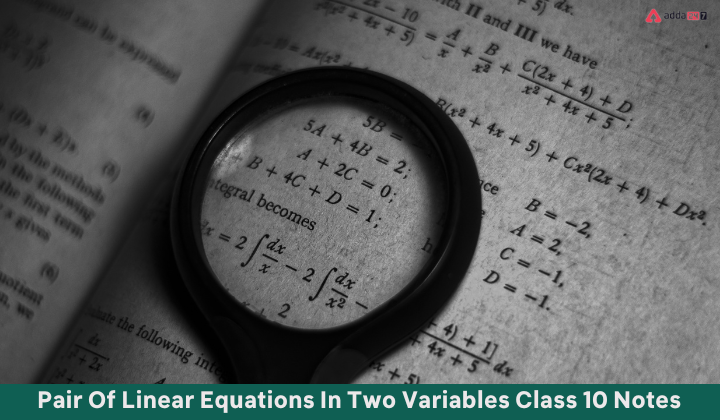Pair Of Linear Equations In Two Variables Class 10 Notes
A linear equation is a straight-line equation. It takes the shape of
ax + by + c = 0
Where a, b and c are the real numbers (a≠0 and b≠0) and x and y are the two variables, Here, a and b are the coefficients, and c is the equation’s constant.
Pair Of Linear Equations in two variable
Two Linear Equations having two same variables are the pair of Linear Equations in two variables.
- a1x + b1y + c1 = 0
- a2x + b2y + c2 = 0
Pair Of Linear Equations In Two Variables Class 10- Graphical Method Of Solution
There will be two lines on the graph because we are displaying two equations.
- 1. If the two lines cross at that specific position, there will only be one solution to the pair of linear equations. It is claimed that the two equations are compatible.
- There will be an endless number of answers if the two lines meet, as every point along the line will contain the answer to the pair of linear equations. It is referred to as a pair of dependent or consistent equations.
- There won’t be a solution if the two lines are parallel because they don’t connect anywhere. It is claimed that the equations are incoherent.
Pair Of Linear Equations In Two Variables Class 10- Algebraic Methods Of Solving
These procedures must be followed in order to solve a pair of linear equations with the variables x and y using the substitution method:
Substitution Method
Step 1: Pick any equation and determine the value of one variable in relation to another, in this case, y in relation to x.
Step 2: Next, change the other equation to use the estimated value of y in terms of x.
Step 3: Since there is only one variable in this linear equation, x, we must now solve it in terms of x.
Step 4: Change the value of x in the provided equations and determine the value of y.
Using this approach, we can eliminate any one of the variables to solve the equations.
Ace your class 10th board exams with Adda247 live classes for class 10th preparation.
Elimination Method
Step 1: Multiply the coefficients of each variable in both equations by a certain number to make them equal.
Step 2: Now combine or divide the equations so that one variable, whose coefficients are the same, is eliminated.
Step 3: To determine the value of the residual variable, solve the equation.
Step 4: Use the equations provided to obtain the value of the other variable by substituting the calculated value of the variable.
Cross Multiplication Method
Given two equations in the form of
a1x + b1y + c1 = 0 and a2x + b2y + c2 = 0, where
We write it in general form as
To apply cross multiplication, we use this diagram
The multiplied pairs are shown by the arrows. The product of the upward and downward arrow pair products must be subtracted from one another.
Using this diagram, we must first write the equations in general form; then, we must calculate the values of x and y and enter those values in the corresponding notations.
To learn more about this chapter click on this link
Equations Reducible To A Pair Of Linear Equations In two variables
In this section, we learn about such equations, which are not linear but can be reduced to pair of linear equations form using the substitution method. Let us understand with the help of an example.
2/x+3/y=4
5/x−4/y=9
In this case, we may make the substitution
1/x = u and 1/y = v
The pair of equations reduces to
2u + 3v = 4 …..(i)
5u – 4v = 9 ….(ii)
From the first equation, isolate the value of u.
u = (4-3v)/2
Now substitute the value of u in eq. (ii)
5[(4-3v)/2] – 4v = 9
Solving for v, we get;
v = 2/23
Now substitute the value of v in u = (4-3v)/2 to get the value of u.
u = 43/23
Since, u = 1/x or x = 1/u = 23/43
and v = 1/y or y = 1/v, so y = 23/2
Hence, the solutions are x = 23/43 and y = 23/2.









 CUET PG 2026 Registration Form OUT at ex...
CUET PG 2026 Registration Form OUT at ex...
 AILET Result 2026 Release Date, How to D...
AILET Result 2026 Release Date, How to D...
 CLAT Result 2026 Out, Download Scorecard...
CLAT Result 2026 Out, Download Scorecard...






